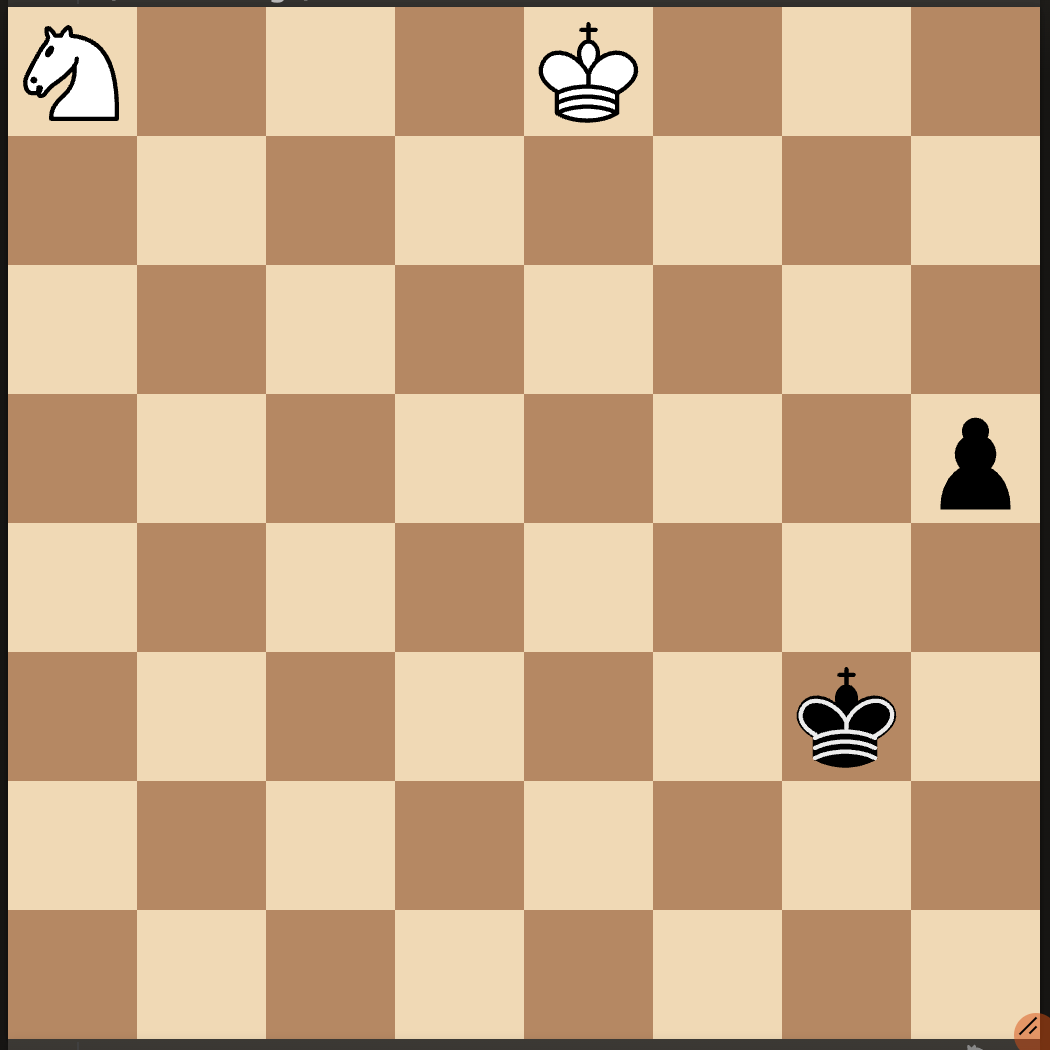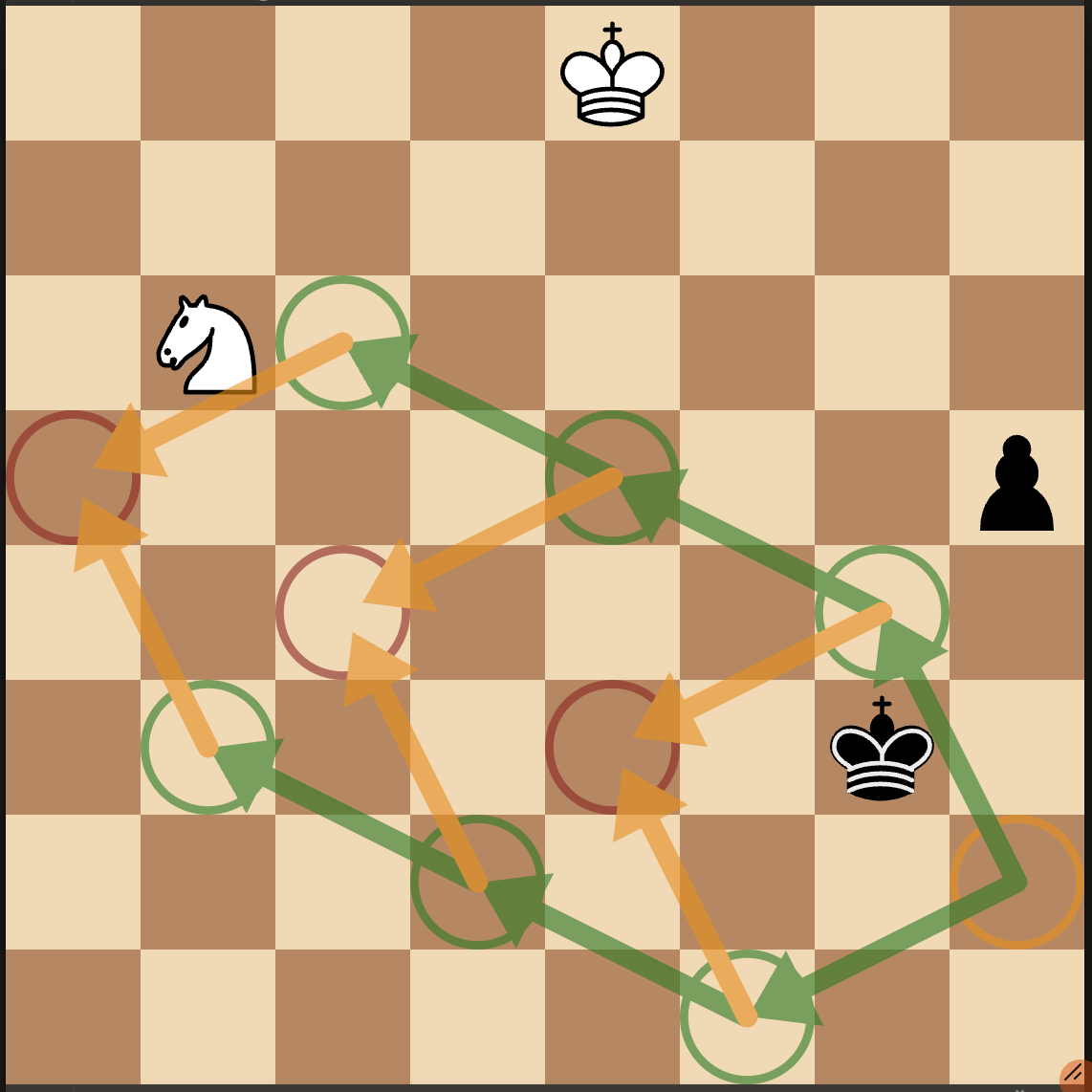In This Issue: From The Skittles Room Endgame Corner, by IM Silas Esben Lund Game of Note, by Travis Henry-Reid Chess Toons En Passant Problems, Problems, curated by Alexander George Editor's Note
Welcome back, fellow chess players, to this edition of the Marshall Chess Club's fortnightly bulletin, The Marshall Spectator.
The Marshall Chess Academy Rapid Championship last weekend was a huge success, with live stream commentary from GM Djurabek Khamrakulov and a live broadcast of the games. Congratulations to FM Linxi Zhu for winning first place in the 1500+ section and Kirill Mcnaughton for winning the U1500 section!
Following the award ceremony, the players were invited to participate in a bughouse tournament organized by IA Carlos Chavez and GM Djurabek Khamrakulov.
The event was the culmination of our camps, which we are looking forward to launching again this summer. If you’re interested in attending, registration is open for our summer camps here. The camp features an all star staff. Along with GM Djurabek Khamrakulov, we will be joined by a strong roster of GM and IM instructors and guests! See below for a confirmed list of instructors and guests. Please note that we are still in talks with other guests, including a five-time classical World Champion!:
GM Djurabek Khamrakulov
GM Andrey Maksimenko
GM Alexander Shabalov
GM Oliver Barbosa
GM Andrew Tang
GM Brewington Hardaway
IM Mykola Bortnyk
IM Bogdan Vioreanu
IM Liam Putnam
GM Mark Paragua
For the month of July, we will be joined by GM Andrei Maksimenko of Ukraine. He graduated from Lviv University of Physical Culture, Chess Department, in 1993 and received a diploma as a chess coach and physical education teacher. In his 26 years of coaching, Andrei has worked with GMs Vasyl Ivanchuk (including work as a second at the World Championship in Las Vegas) Andrei Volokitin (first board of the Ukrainian national team). This summer, Andrei will bring the “soviet school of chess” to New York, and we look forward to welcoming him.
Looking back over the last two weeks, we have had a plethora of events for our members to play in.
The Monthly Under 2400 that concluded on April 20 had 40 players registered and was won by Aidan Baker who scored 4.5 out of 5 to win $667. IM Jay Bonin and Jack Boyer-Olson scored 4 out of 5 to win $233.50 each, while Samant Sen won a $200 class prize for a 3.5 out of 5 performance. The following 4 players won $41.75 each for their 3.5 out of 5 score: Tim Shvarts, Chase Knowles, Alan Price, and Nathan Peyton.
The Monthly Under 1800 that concluded on April 20 had 52 players registered and was won by Liam L Kojuharov, who scored 4.5 out of 5 to win the $850 first place prize. Kara Chan, Aiden Chan, Sean Rong, and Ayden Lim scored 4 out of 5 to win $265.50 each, while Patrice Bericourt, Holden Wen, and Brian Liu scored 3 out of 5 to win a class prize of $85 each.
The Rated Beginner Open on April 20 had 58 players registered and concluded with the following 6 players winning $120.83 each for their perfect 3 out of 3 score: Gordon Sun, Noah Spiegel, Charles Adelman, Jonathan Chen, Abraham Kondo-Chung and Philip Anderson.
The Under 2000 Morning Action on April 19 had 62 players registered and was won by Armaan C Jain, Dante Kai Mayeno, and Jonathan Hsieh, who scored a perfect 3 out of 3 to win $181 each. Adurami Lasile, Artreya Marballi, and Steven Mcsween scored 2.5 out of 3 to win $77.67 each.
The Morning Masters on April 19 had 6 players registered and was won by Mark DeDona and Ian Nicholson who scored 2.5 out of 3 to win $37.50 each.
The Friday Rapid on April 18 had 19 players registered and was won by Shami Abdullayev and Dominic Paragua who scored 3.5 out of 4 to win $67.50 each, while the following 4 players won $23 each for their performance: Jayden Feng, Benito Kestelman, Chris DeDona, and Jeffrey Ho.
The Afternoon Game 50 on April 17 had an excellent turnout with 24 players registered. The following 5 players won $15 each for their perfect 2 out of 2 performance: Riju Bhattacharjee, Chris DeDona, Alexi Julian De La Nuez, Lamine Amir Gordon, and Steven Wong McSween.
The Thursday Action on April 17 had 43 players registered and was won by FM Leif Pressman, who scored 4 out of 4 to win $162. FM Marcus Ming Miyasaka, Evan S. Rosenberg, and Armaan C Jain scored 3.5 out of 4 to win $90 each.
The Weekly Under 1600 that concluded on April 16 had 44 players registered and was won by Marco Ramdas, who scored 5.5 out of 6 to win $366.67. Jonathan Gordon won a class prize of $146.67 for a score of 4 points, while the following 5 players won $73.33 each for their 4.5 out of 6 score: Jeremiah McFarland, Patrice Bericourt, Daniel Fusco, David Shenk, and Ryan Lefkowitz.
The Weekly Under 2200 that concluded on April 16 had 36 players registered and was won by Alexander Golosovker who scored 5.5 out of 6 to win the $360 first place prize. Aleksandr Gutnik and David Timmerman scored 4.5 out of 6 to win $180 each, while Jesse Sun won a $120 class prize for a 3.5 out of 6 performance and Keyla Acevedo won $60 for scoring 3 out of 6.
The Marshall Masters on April 15 had 12 players registered and was won by Bryan Weisz who scored 3.5 out of 4 to the $160 first place prize. CM Sasha Schaefer scored 3 out of 4 to win clear second place and $110, while IM Jay Bonin, CM Kyle Dong, Joshua Block, and William Aepli scored 2.5 out of 4 to win $22.50 each.
The Weekly FIDE Monday that concluded on April 14 had 30 players registered and was won by Ethan Kozower and Aleksandr Gutnik who scored 5 out of 6 to win the $250 each. FM Grant Xu scored 4.5 out of 6, winning $100, while Nicklas S Breskin and Oliver Spohngellert scored 3 out of 6 to win $75 each.
The Weekly Monday Under 1800 that concluded on April 14 had 32 players registered and was won by Ben Davar who scored 5.5 out of 6 to win the $214 first place prize. Brian James Girlbert, Mark Limperis, and Peiyu Shi scored 4.5 out of 6 to win $124.67, while Dan Yates and Valery Zajkov scored 3.5 out of 6 to win $27 each.
The Rated Beginner Open on April 13 had 65 players registered and concluded with the following 5 players winning $157.60 each: Milan Chadha, Reece Jackson, Avya Chopra, Noah Garrido, and Aidan Kassir.
The ALTO on April 13 had 17 players registered and was won by Alisher Podavonov who scored a perfect 4 out of 4 to win the $102 first place prize. IM Jay Bonin and Matthew Shirvell scored 3 out of 4 to win $34 each, while the following 4 players won $12.75 for their 2.5 out of 4 score: Chris Weldon, Rohit Jagga, Rowan Foley, and Kenny Bollin.
We look forward to seeing you at the club soon!
Endgame Corner, by IM Silas Esben Lund
The column this time is about knight versus pawn, with special focus on what I call the ring system. I presented these ideas in my 2017 work for Quality Chess, Sharp Endgames. Try to solve the 3 exercises first, the solution will be presented later.
You can play through the games with annotations here.
Exercise 1:
White to move and draw. (Promotion square is h1.) 1/2-1/2
Exercise 2:
White to move and win.
Exercise 3:
White to move and draw. (Promotion square on h1.) Would you play 1. Nb6 (or 1. Nc7 on your first move?) 1/2-1/2
Exercise 1:
1. Ne3+ (The edge pawn cannot be stopped on the corner square: 1. Ng3 h2 2. Kb7 Ke1 3. Kc6 Kf2 4. Nh1+ Kg2 The knight is trapped and the pawn will promote.) 1... Ke2 2. Ng4
The pawn is stopped on h2, and a ring is formed from the 4 squares h2-f1-e3-g4. All White has to do now to make a draw is to stay within this ring. Kf3 3. Nh2+ Kg2 4. Ng4 Kg3
White uses tactics to stop promotion. 5. Ne3 h2 6. Nf1+ Kg2 7. Nxh2 1/2-1/2
Exercise 2:
A knight's pawn on the seventh rank presents a special case. 1. Kb8 This 'cross-over' is essential to win: White deliberately steps in front of his own pawn. (1. Kb6 Nd7+ Black is inside the ring of b8-d7-c5-a6 and can stay inside it: 2. Kc7 Nc5 3. b8=Q Na6+) (1. b8=Q Nc6+) 1... Nc6+ (1... Nd7+ White is inside the ring but cannot save the game. 2. Kc8 Nb6+ (2... Nc5 3. b8=Q) 3. Kd8) 2. Kc7 Nb4 3. Kb6 (3. b8=Q Na6+) 3... Nd5+ 4. Kb5 (Or 4. Ka5 Ne7 5. Kb5) 4... Nc7+ 5. Ka5 1-0
Exercise 3:
If the knight comes from afar, it helps to map out the board to help it approach the pawn in the right way. Due to the limited size of the chess board, a maximum of 3 rings are needed. Incidentally, the second and third rings are more like ellipses. The main points of the ring system: 1) The pawn must be stopped at h2 at the latest. 2) Ring 1 consists of the squares h2-f1-e3-g4. 3) The connecting point of ring 1 is e3. From e3, there are 2 roads for the knight to reach h2. 4) Ring 2 is created by expanding ring 1: instead of closing (on e3), we continue h2-f1 via d2 and now closes on c4 instead. The same logic applies to h2-g4 via e5, and then close on c4 from the other side. The full ring 2 is h2-f1-d2-c4-e5-g4-h2. 5) Ring 3 is created by expanding ring 2: instead of closing (on c4), we continue via b3 and close on a5. Same goes for e5-c6-a5. The full tour of ring 3 is h2-f1-d2-b3-a5-c6-e5-g4-h2.
1. Nb6
The knight is aiming for the connecting point c4 of ring 2. (1. Nc7 h4 2. Ne6 h3)
1... h4 2. Nc4 (2. Nd5 Kf3 Even if the pawn were on h5, it would be a win for Black.)
2... Kf3 A devilish winning try, stopping the direct jump to e3, and instead forcing White to choose the correct side path of the knight. (2... h3 3. Ne3 let's the knight into ring 1 without a fight.)
3. Ne5+ The argument for choosing the correct knight move is the check that eliminates the pawn! (3. Nd2+ Ke2 The white knight is unable to make it back into the ring system. (3... Kf2 4. Ne4+ Kg2 5. Ng5 The pawn is stopped on h3, with the 'luxury ring' h3-f2-e4-g5.) (3... Kg2 4. Nc4 White corrects his mistake by 'jumping back' into the connecting point of ring 2.))
3... Kg3
(3... Kf4 4. Ng6+ eliminates the pawn.) 4. Nc4 Again the jump back into the connecting point. This difficult maneuver must be learned as it is not easy going backward, away from the passed pawn.
4…h3 (4... Kf4 5. Nd2 h3 6. Nf1) 5. Ne3 The connecting point of ring 1. h2 6. Nf1+ Kg2 7. Nxh2 The knight will prefer to jump directly into the connecting points (c4, then e3) as it is the most direct way to a draw. Notice that the connecting point of ring 3 (on a5) wasn't used in this example. The black king is trying to make it difficult, forcing the knight to choose the correct (longer) side path, left of right, on the way to h2. In the next column, we shall see positions where all 3 rings, and thereby the whole board, is used to the fullest in order to stop the pawn. 1/2-1/2
IM Silas Esben Lund, Marshall Spectator Contributor
Game of Note, by Marshall Chess Club Member Travis Henry-Reid
A recent game between two of Marshall's most active members
You can play through the game here.
Travis Henry-Reid vs IM Jay Bonin Grünfeld Defense: Exchange Variation, Modern Exchange Variation
1. Nf3 Nf6 2. c4 g6 3. d4 Bg7 4. Nc3 d5 5. cxd5 Nxd5 6. e4 Nxc3 7. bxc3 O-O 8. Be2 c5
9. O-O b6 10. Be3 Bb7 11. Qc2 cxd4 12. cxd4 Nc6 13. Rad1 Rc8 14. Qb1 M. Kulistak–A. Platel, Tatranské Zruby 2016... Qa4 has also been played.
14... e6 15. a3 Terrible move that doesn’t do anything. (More aggressive and thematic would have been 15.h4.-comment by Greg Keener.)
15... Qd6 16. d5 exd5 17. exd5 Ne7 18. Bd2 Nxd5 19. Bb4 Qe6 20. Rxd5 Bxd5 21. Ba6 Bxf3 I knew I was falling behind.
22. Bxc8 Rxc8 23. gxf3 a5 24. Re1 Qd5 25. Be7 Qxf3 26. Qxb6 Be5
My opponent was trying to trick me here (27. Rxe5 ... Rc1+, 28. Re1 ... Rxe1#), but this move is actually a mistake. 27. Qe3 (27. Rxe5 Rc1+ 28. Re1 Rxe1#) 27... Qg4+ Evidently, it was better to take, but I had a feeling Black would want to keep the queens on a little longer.
28. Kh1 Bd4 29. Qg3 Qxg3 Trading is now a mistake that gave me chances to hold. 30. fxg3 Re8 31. Rd1 My opponent complimented this move after the game.
31... Rxe7 32. Rxd4 Re3 33. Ra4 Re5 34. Kg2 f5 35. Kf3 Kf7 36. h4 Kf6 37. Rc4 “Even” position.
37... Rb5 38. Ra4 h6 39. Kf4 An inexplicable, ghastly move. 39... Rb3 0-1
Travis Henry-Reid, Marshall Chess Club Member
En Passant
Magnus Carlsen, the world No 1, soared to a new landmark in chess history last weekend, when the 34-year-old won all his nine games in the Grenke Freestyle Open at Karlsruhe, Germany.
GM Alireza Firouzja pounced on a blunder by GM Praggnanandhaa Rameshbabu to win the battle of the players who started day two in second place and catch GM Vladimir Fedoseev in the 2025 Superbet Rapid & Blitz Poland lead. GM Aravindh Chithambaram moved up to third place after finding the move of the day to beat GM Veselin Topalov, while GMs Levon Aronian and Maxime Vachier-Lagrave also scored 4/6 to move up the standings.
Starting April 29 on Twitch, the Botez sisters will serve as commentators for the sixth edition of PogChamps, Chess.com’s series of amateur tournaments featuring a variety of internet celebrities and athletes. It’s a perfect showcase for their irreverent style: “You don’t have to take chess super seriously to enjoy it,” Alexandra tells Rolling Stone. “Which is also kind of the spirit of PogChamps, even though everyone will be very competitive about it.” A dozen competitors, including professional soccer player Eberechi Eze, Fortnite streamer Mongraal, YouTube adventurer Inoxtag, and popular VTuber Filian will compete for a $100,000 prize — and, of course, bragging rights.
After carefully reviewing the numerous applications received, the special panel appointed by the FIDE Council has selected eleven chess players, coaches, and organizers to benefit from the first installment of FIDE’s 2025 support program for chess veterans.
Chess Toons
Problems, Problems, curated by Alexander George
T. R. Dawson, 1927
Black is to move. Specify one move that Black must have played.
---
Last issue’s puzzle: (Lapierre, 1959):
Mate in 2.
Solution: After the R on a1 moves to d1, it looks like mate the following move with Rd8. But the problem is that Black can play 1...O-O and escape. Now, does it make a difference if the aR gets to d1 via castling? Yes! Because we can prove that if White can castle then Black cannot! Why? Well, if White can castle, then the White king and the White rook on a1 have never moved. Therefore, the R on d4 is a promoted piece. But wherever it exited the 8th rank after promotion, either the Black king or the Black rook on h8 must have moved - in either case, Black cannot castle. Thus, if White can castle then Black can't; by castling, White can make it be the case that Black cannot! So, we have in sum: 1.Rad1? O-O! and 1.O-O-O! any 2.Rd8 mate.
---
Alexander George
Editor's Note
As always, if you have any feedback, comments, or would like to submit an article please contact us directly at td@marshallchessclub.org.
Enjoy, and thanks for reading!
The Marshall Chess Club
23 West Tenth Street New York, NY 10011
212.477.3716
Thanks for reading The Marshall Spectator! Subscribe for free to receive new posts and support the club.
























